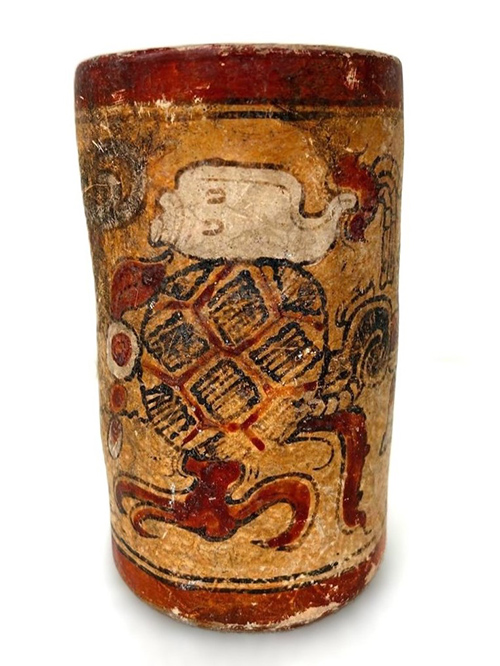Maya Cylinder Vase

This Maya cylinder vase dates to the Late Classic Period of 550 to 830 CE. The straight-walled shape of this vessel indicates that it was likely used to drink cacao, or chocolate, beverages. These bitter drinks were made with cacao beans, water, and spices like chili or cinnamon. They were often consumed in a ritual context.
The ancient Maya used local clays and created their ceramics with the coil-building method. The potter started with a flat bottom and added clay coils to the desired height. Then, they smoothed the walls to make them even. After the shape was finalized, the potter left the piece to air dry and then burnished it to create a smooth surface for painting. The majority of pigments were created from iron oxide, manganese, and other ground minerals, resulting in a range of colors. After the painting was complete, the piece was fired at low temperature in an open pit.
Late Classic Period Maya artists were members of the elite class. Only the highest levels of society learned the hieroglyphs and iconography necessary to create the imagery on ceramic vessels. This Maya cylinder vase is decorated in the codex style, meaning that it resembles a Classic Maya book with red borders at the top and bottom and a white background. Despite this fact, the design does not contain any actual hieroglyphic writing. The decorations on this vessel possibly depict a scene from the Maya underworld, or Xibalba, with a conch shell and some type of water-dwelling underworld creature. The lack of hieroglyphs may indicate that the vessel is not from one of the major Classic period city-states, but rather somewhere on the periphery of the Maya area. Because this vase is a part of the collection recently acquired from UNC-Wilmington, we do not have provenance documents identifying its source.
This Maya cylinder vase is on display in Museum of World Cultures: Highlights from the UNC-Wilmington Collection through February 14, 2026.

